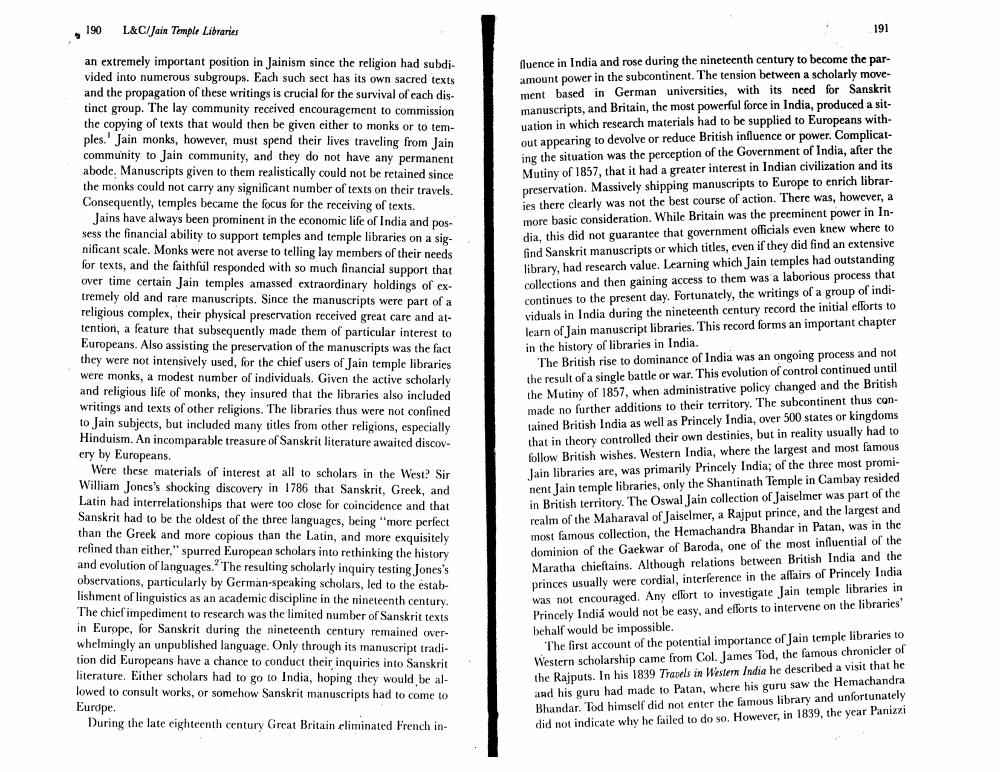Book Title: Western Discovery Of Jain Temple Libraries Author(s): Donald Clay Johnson Publisher: Donald Clay Johnson View full book textPage 2
________________ 190 L&C/Jain Temple Libraries an extremely important position in Jainism since the religion had subdivided into numerous subgroups. Each such sect has its own sacred texts and the propagation of these writings is crucial for the survival of each distinct group. The lay community received encouragement to commission the copying of texts that would then be given either to monks or to temples.' Jain monks, however, must spend their lives traveling from Jain community to Jain community, and they do not have any permanent abode, Manuscripts given to them realistically could not be retained since the monks could not carry any significant number of texts on their travels. Consequently, temples became the focus for the receiving of texts. Jains have always been prominent in the economic life of India and possess the financial ability to support temples and temple libraries on a significant scale. Monks were not averse to telling lay members of their needs for texts, and the faithful responded with so much financial support that over time certain Jain temples amassed extraordinary holdings of extremely old and rare manuscripts. Since the manuscripts were part of a religious complex, their physical preservation received great care and attention, a feature that subsequently made them of particular interest to Europeans. Also assisting the preservation of the manuscripts was the fact they were not intensively used, for the chief users of Jain temple libraries were monks, a modest number of individuals. Given the active scholarly and religious life of monks, they insured that the libraries also included writings and texts of other religions. The libraries thus were not confined to Jain subjects, but included many titles from other religions, especially Hinduism. An incomparable treasure of Sanskrit literature awaited discovery by Europeans. Were these materials of interest at all to scholars in the West? Sir William Jones's shocking discovery in 1786 that Sanskrit, Greek, and Latin had interrelationships that were too close for coincidence and that Sanskrit had to be the oldest of the three languages, being "more perfect than the Greek and more copious than the Latin, and more exquisitely refined than either," spurred European scholars into rethinking the history and evolution of languages. The resulting scholarly inquiry testing Jones's observations, particularly by German-speaking scholars, led to the establishment of linguistics as an academic discipline in the nineteenth century. The chief impediment to research was the limited number of Sanskrit texts in Europe, for Sanskrit during the nineteenth century remained overwhelmingly an unpublished language. Only through its manuscript tradition did Europeans have a chance to conduct their inquiries into Sanskrit literature. Either scholars had to go to India, hoping they would be allowed to consult works, or somehow Sanskrit manuscripts had to come to Europe. During the late eighteenth century Great Britain eliminated French in 191 fluence in India and rose during the nineteenth century to become the paramount power in the subcontinent. The tension between a scholarly movement based in German universities, with its need for Sanskrit manuscripts, and Britain, the most powerful force in India, produced a situation in which research materials had to be supplied to Europeans without appearing to devolve or reduce British influence or power. Complicating the situation was the perception of the Government of India, after the Mutiny of 1857, that it had a greater interest in Indian civilization and its preservation. Massively shipping manuscripts to Europe to enrich libraries there clearly was not the best course of action. There was, however, a more basic consideration. While Britain was the preeminent power in India, this did not guarantee that government officials even knew where to find Sanskrit manuscripts or which titles, even if they did find an extensive library, had research value. Learning which Jain temples had outstanding collections and then gaining access to them was a laborious process that continues to the present day. Fortunately, the writings of a group of individuals in India during the nineteenth century record the initial efforts to learn of Jain manuscript libraries. This record forms an important chapter in the history of libraries in India. The British rise to dominance of India was an ongoing process and not the result of a single battle or war. This evolution of control continued until the Mutiny of 1857, when administrative policy changed and the British made no further additions to their territory. The subcontinent thus contained British India as well as Princely India, over 500 states or kingdoms that in theory controlled their own destinies, but in reality usually had to follow British wishes. Western India, where the largest and most famous Jain libraries are, was primarily Princely India; of the three most prominent Jain temple libraries, only the Shantinath Temple in Cambay resided in British territory. The Oswal Jain collection of Jaiselmer was part of the realm of the Maharaval of Jaiselmer, a Rajput prince, and the largest and most famous collection, the Hemachandra Bhandar in Patan, was in the dominion of the Gaekwar of Baroda, one of the most influential of the Maratha chieftains. Although relations between British India and the princes usually were cordial, interference in the affairs of Princely India was not encouraged. Any effort to investigate Jain temple libraries in Princely India would not be easy, and efforts to intervene on the libraries' behalf would be impossible. The first account of the potential importance of Jain temple libraries to Western scholarship came from Col. James Tod, the famous chronicler of the Rajputs. In his 1839 Travels in Western India he described a visit that he and his guru had made to Patan, where his guru saw the Hemachandra Bhandar. Tod himself did not enter the famous library and unfortunately did not indicate why he failed to do so. However, in 1839, the year PanizziPage Navigation
1 2 3 4 5 6 7 8
